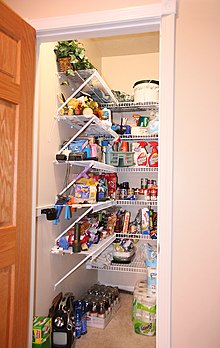Pantry
**1. Historical Background and Evolution:**
– Etymology: ‘Pantry’ originates from the Old French term ‘paneterie’, derived from the Latin ‘panis’ meaning bread.
– Medieval Origins: Pantries in the Late Middle Ages were dry rooms for bread storage and food preparation, with a pantler overseeing operations.
– Colonial and Victorian Era: US pantries evolved from Colonial American butteries, while Victorian British houses had separate rooms for various food-related tasks.
– Butler’s Pantry: Traditionally used for silver storage and meal serving, modern versions act as staging areas.
– Cold Pantry: Developed before modern refrigeration, it used air circulation for cooling and stored perishable items like butter, eggs, and milk.
**2. Types of Pantries:**
– Asian Pantry: Traditional Asian kitchens used wooden cabinetry for pantry functions like Japan’s mizuya tansu cabinets.
– Butler’s Pantry: Utility rooms in large houses for serving items traditionally, now serving as meal staging areas.
– Cold Pantry: Specifically designed for storing perishable items that require cooling, ideal for food stocks like bread, butter, and pastries.
– Hoosier Cabinet: Developed in the early 1900s, combining pantry storage with kitchen functionality, popular in American kitchens until the 1930s.
**3. Cultural Significance and Usage:**
– Historical Significance: Pantries were essential in American homes during the Victorian era and up to the Second World War due to small, utilitarian kitchens.
– Laura Ingalls Wilder’s detailed description of a farmhouse pantry in ‘These Happy Golden Years’ highlights their importance.
– Pantry Raids: Common theme in children’s literature and early 20th-century advertising, showcasing the centrality of pantries in households.
– Pantry Shelving: Gained popularity in American households post-Vietnam War, advocated by authors like Catharine E. Beecher and Harriet Beecher Stowe.
**4. Related Concepts:**
– Larder: Room for storing food, especially meat.
– Root Cellar: Underground storage space for preserving food.
– Shaker-Style Pantry Box: Traditional wooden pantry storage container.
– Storage Room: General term for a room used for storing items.
– Utility Room: Multi-functional room for various household tasks.
**5. Additional Resources and Further Reading:**
– ‘The Victorian House’ by Judith Flanders offers insights into historical pantry usage.
– ‘The Pantry: Its History and Modern Uses’ by Catherine Seiberling Pond explores the evolution and contemporary relevance of pantries.
– External Links: Wiktionary and free dictionary provide additional information on the term ‘pantry’.
– MasterClass provides a brief history of the butler’s pantry, while Instructables.com offers instructions on creating a California Cooler.

